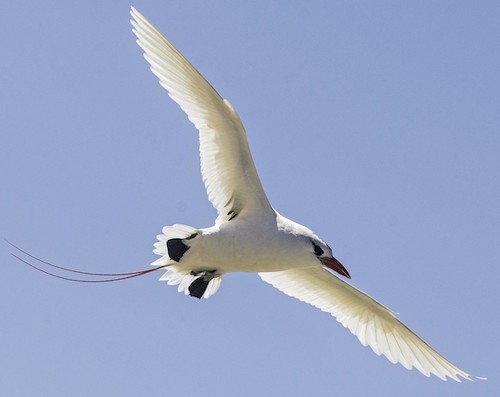Phaethontidae – Tropicbirds

The Phaethontidae or Tropicbirds are a family of tropical pelagic seabirds now classified in their own order Phaethontiformes. Their relationship to other living birds is unclear, and they appear to have no close relatives. There are three species in one genus, Phaethon. They have predominantly white plumage with elongated tail feathers and small feeble legs and feet.
They range in size from 76cm to 102cm in length and 94cm to 112cm in wingspan. Their plumage is predominantly white, with elongated central tail feathers. The three species have different combinations of black markings on the face, back, and wings. Their bills are large, powerful and slightly decurved. Their heads are large and their necks are short and thick. They have totipalmate feet (that is, all four toes are connected by a web). Their legs are located far back on their body, making walking impossible, so that they can only move on land by pushing themselves forward with their feet.
The tropicbirds’ call is typically a loud, piercing, shrill, but grating whistle, or crackle. These are often given in a rapid series when they are in a display flight at the colony. In old literature they were referred to as boatswain (bo’sun’/bosun) birds due their loud whistling calls.
Tropicbirds frequently catch their prey by hovering and then plunge-diving, typically only into the surface-layer of the waters. They eat mostly fish, especially flying fish, and occasionally squid.[10] Tropicbirds tend to avoid multi-species feeding flocks, unlike the frigatebirds, which have similar diets.
They are usually solitary or in pairs away from breeding colonies. There they engage in spectacular courtship displays. For several minutes, groups of 2–20 birds simultaneously and repeatedly fly around one another in large, vertical circles, while swinging the tail streamers from side to side. If the female likes the presentation, she will mate with the male in his prospective nest-site. Occasionally, disputes will occur between males trying to protect their mates and nesting areas.
Tropicbirds generally nest in holes or crevices on the bare ground. The female lays one white egg, spotted brown, and incubates for 40–46 days. The incubation is performed by both parents, but mostly the female, while the male brings food to feed the female. The chick hatches with grey down. It will stay alone in the nest while both parents search for food, and they will feed the chick twice every three days until fledging, about 12–13 weeks after hatching. The young are not able to fly initially; they will float on the ocean for several days to lose weight before flight.
Tropicbird chicks have slower growth than nearshore birds, and they tend to accumulate fat deposits while young. That, along with one-egg clutches, appears to be an adaptation to a pelagic lifestyle where food is often gathered in big amounts, but may be hard to find.
According to the IOC there are just three species in this family, which are:
Red-billed Tropicbird Phaethon aethereus
Red-tailed Tropicbird Phaethon rubricauda
White-tailed Tropicbird Phaethon lepturus
-
Red-billed Tropicbird Phaethon aethereus
IUCN Species Status -
Red-billed Tropicbird Phaethon aethereus
Species AccountSound archive and distribution map. -
Red-billed Tropicbird Phaethon aethereus
Species AccountThe red-billed tropicbird (Phaethon aethereus), also known as the boatswain bird is a tropicbird, one of three closely related seabirds of tropical oceans. -
Red-billed Tropicbird Phaethon aethereus
Cornell Species AccountThe Red-billed Tropicbird is split into three subspecies only one of which occurs in the northwest corner of the Indian Ocean. -
Red-tailed Tropicbird Phaethon rubricauda
Species AccountThere are only three species of tropicbirds around the world -
Red-tailed Tropicbird Phaethon rubricauda
IUCN Species Status -
Red-tailed Tropicbird Phaethon rubricauda
Species AccountSound archive and distribution map. -
Red-tailed Tropicbird Phaethon rubricauda
Species AccountThe red-tailed tropicbird (Phaethon rubricauda) is a seabird that nests across the Indian and Pacific Oceans. It nests in colonies on oceanic islands. -
White-tailed Tropicbird Phaethon lepturus
IUCN Species Status -
White-tailed Tropicbird Phaethon lepturus
Species AccountSound archive and distribution map. -
White-tailed Tropicbird Phaethon lepturus
Species AccountThe white-tailed tropicbird (Phaethon lepturus) is a tropicbird, smallest of three closely related seabirds of the tropical oceans and smallest member of the order Phaethontiformes. It occurs in the tropical Atlantic, western Pacific and Indian Oceans. -
White-tailed Tropicbird Phaethon lepturus
Cornell Species AccountThe White-tailed Tropicbird is the smallest of the three species of tropicbird. It resembles the other species in its mostly-white plumage, vaguely tern-like shape, and long, tapered tail.
-
Number of bird species: 3
-
Seabirds
| By Peter Harrison | Christopher Helm | 1991 | Hardback | 448 pages, 324 distribution maps, 88 colour plates, line drawings | ISBN: 9780713635102 Buy this book from NHBS.com
-
Southern Oceans Seabird Study Association
WebsiteSOSSA was founded by members of the New South Wales Albatross Study Group (NSWASG) in 1994. It was set up to be an umbrella organisation for many study groups concerned with studies of Southern Ocean bio-diversity. SOSSA is a wildlife research and conservation group which consists of dedicated people both professional and amateur. These people share a common interest and concern for the environment and the wildlife of the Southern Oceans
